Is Climate Change Responsible for Our Worst Fire Month on Record?
May of this year was the worst on record since I began reporting waste and recycling facility fire incidents in 2016. In May, we incurred 49 reported fire incidents. Then came June. In June, we incurred 50 reported fire incidents. That is more than 1.5 fire incidents each day. Of those fires, 27 occurred at waste, paper and plastic facilities; 14 occurred at scrap metal facilities; three occurred at construction and demolition (C&D) facilities; three occurred at hazmat facilities; and three occurred at organics facilities.

May of this year was the worst on record since I began reporting waste and recycling facility fire incidents in 2016. In May, we incurred 49 reported fire incidents. Then came June. In June, we incurred 50 reported fire incidents. That is more than 1.5 fire incidents each day. Of those fires, 27 occurred at waste, paper and plastic facilities; 14 occurred at scrap metal facilities; three occurred at construction and demolition (C&D) facilities; three occurred at hazmat facilities; and three occurred at organics facilities. Similar to May, at Fire Rover, we responded to 122 fire incidents at our clients’ facilities.
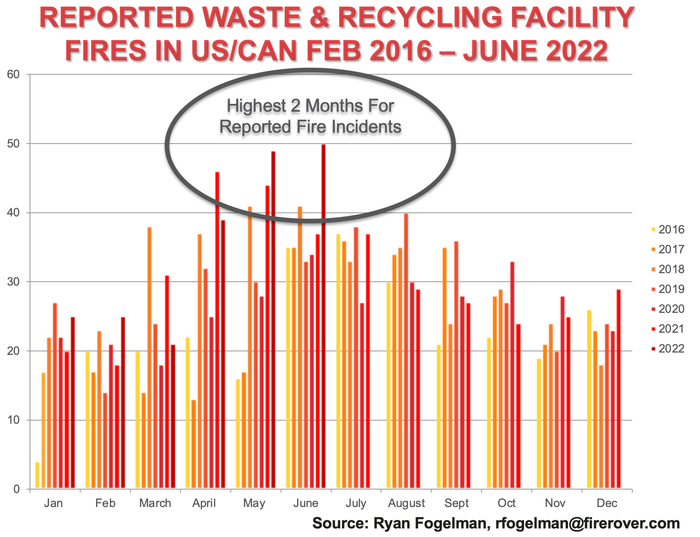
My data only includes the fire incidents that were “reported” by a news outlet, and since I began analyzing this data six years ago, 2022 is turning out to be the worst year for reported fire incidents. Looking at the number of fire incidents using year-to-date (YTD) numbers, 2022’s 209 reported incidents are outpacing all prior years, including last year’s top and 2018’s lithium-ion battery wave.

Not only are 2022’s overall numbers the highest overall so far, but this year has seen three of the highest months of reported fire incidents. In fact, March was the only month where this year was not in the top two.
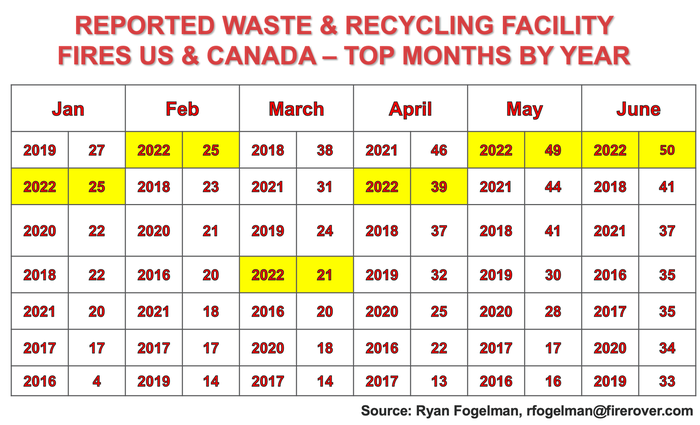 I estimated 2022 based on a weighted run rate using the actual data from January through June, and if we remain at a similar pace, 2022 will be the worst year for reported fire incidents (estimated 418), coming in well above the historical average of 326 reported fires.
I estimated 2022 based on a weighted run rate using the actual data from January through June, and if we remain at a similar pace, 2022 will be the worst year for reported fire incidents (estimated 418), coming in well above the historical average of 326 reported fires.

When it comes to data, you will always hear me say that we really don’t know anything until we see how the future turns out. With that being said, we can look at patterns and similarities/differences in trends.
What is Causing the Increase in Fire Incidents?
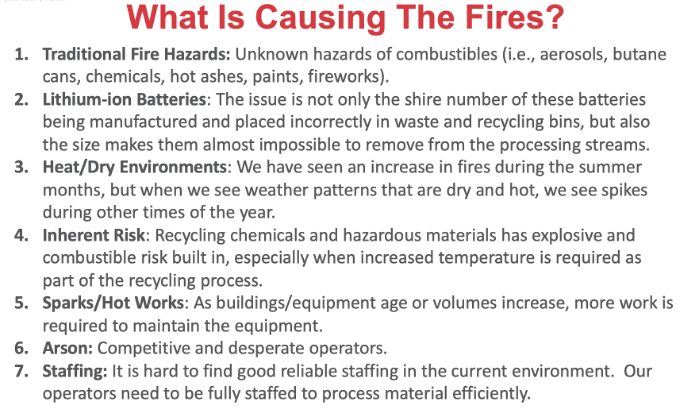
If you had a chance to read the 2021 annual report I published in February, I shared my thoughts on the cause of these fire incidents. Most of these potential causes have been issues we have been dealing with for decades, including the increase in lithium-ion batteries in our waste and recycling streams and the yearly “summertime spike” each year, but this year has been hotter and dryer than years past, which presents more challenges.
Hot & Dry Environments
It should come as no shock to any of us that we tend to have more fires when it is hot and dry in our everyday environments. According to the NOAA Climate Report, the average temperature in June was almost 71 degrees Fahrenheit, which is 2.2 degrees higher than average and the 15th warmest month on record in the past 128 years. As you can see from the map below, parts of the country reached significantly higher temperatures, especially in the Southern regions.
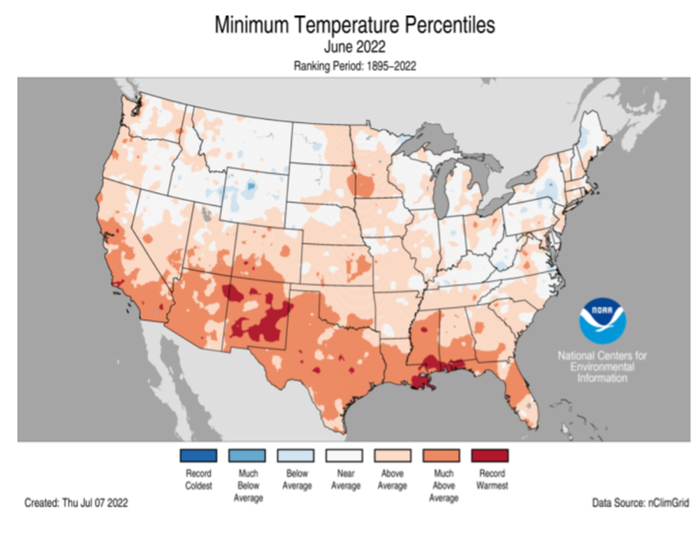
If we look at the months of May and June specifically, typically the beginning of the summertime spike in fire incidents, there is a direct correlation between heat and dryness since I began reporting these fire incidents in 2016. This chart by the NOAA National Centers for Environmental Information shows the trend of the hottest May and June periods, highlighting that 2018, 2021 and 2022 were above the average.
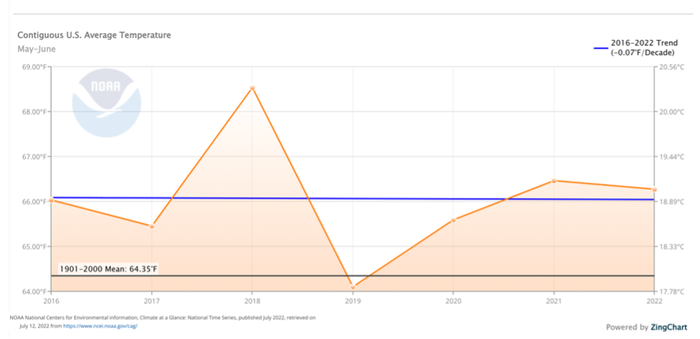
Similarly, when we evaluate May and June from a historical perspective, the same years of 2018, 2021 and 2022 have reported fire incidents higher than the six-year average.
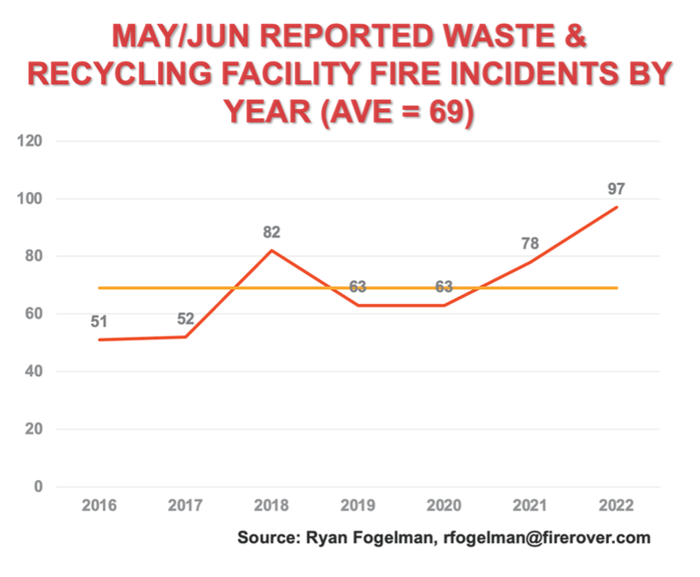
Not only are we dealing with hotter weather across the U.S., but we are also dealing with dryer weather. The NOAA reported that June’s rainfall was .60 inches below average, the 12th driest in history. According to the June 28 U.S. Drought Monitor report, 47.7 percent of the contiguous U.S. was in drought. Due to monsoon rains, parts of the Southwest saw a reduction in extreme to exceptional drought, but drought conditions erupted and/or expanded across parts of the mid-Mississippi Valley and Southeast.
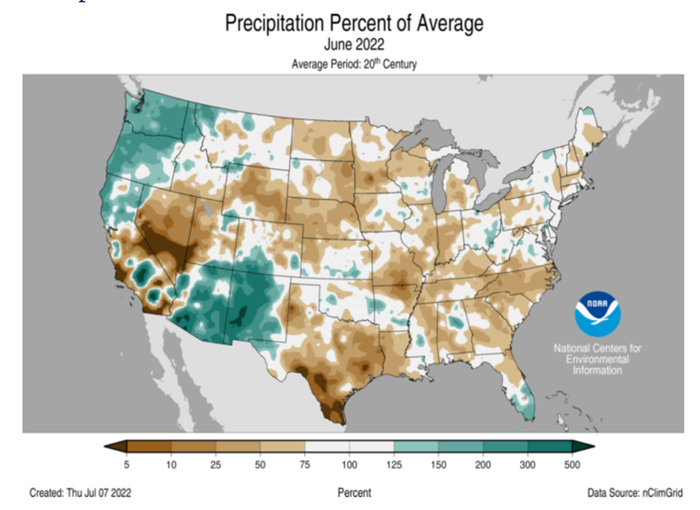
When looking at the data from the beginning of the year to now, the total rainfall for the U.S. was 1.47 inches below average, the third driest on record. Precipitation was also below average across much of the West and Deep South, as well as portions of the central Plains and Southeast, tying to the high heat numbers. California ranked driest on record while Nevada and Utah ranked second and third driest for this six-month period, respectively. Texas ranked sixth driest. According to my data, so far this year, California accounted for 22 fire events versus the average YTD of 18.5 from years past. Texas was similar with 12 reported fire incidents YTD versus 7.6 on average from 2016 to 2022.
One Solution: Use Less Water
Global warming and dryer environments are problems of such an immense scale that we would be hard-pressed to develop a solution that will change our trajectory in the short term, but I do believe we have a solution for dryer environments in our Fire Rover early detection fire mitigation solution. Using less water when fighting fires is an approach that has benefits on both the local and global scale to help our environment.
When we first started Fire Rover, a number of folks would question the amount of water we have in our tanks. Our traditional solution uses 1,000 gallons of water and our environmentally friendly encapsulator agent. The reason we use this amount of water is to have enough spray to fight a fire before the authorities (typically dispatched with more than enough time to spare) arrive on the scene and perform final extinguishment activities.
What we have learned is that most of the time our 1,000 gallons are more than enough to deal with the hazards we face in the waste and recycling occupancy. More often than not, we spray for one minute or less using less than 10 percent of our reserve. In the rare occurrence (less than 20 incidents since 2015) where the fire department or fire brigade needs to come onsite and extinguish, they are showing up to a controlled situation that needs more water to remove hot spots and wet the collateral material.
Our approach was confirmed by a technical report, “Reducing Water Demands Using Innovative Fire Protection Solutions,” published by FM Global in April 2020.

Solutions utilizing automated water cannons used 92 percent less water to extinguish a low piled storage situation. Keep in mind these results were evaluated in controlled test environments. In live environments, our Fire Rover solution deploys the benefits outlined by FM’s report and creates the most effective spray patterns in any situation. This has led to successful putouts as well as success while dealing with other factors such as higher piles, human activity onsite, unique hazards and collateral assets, amongst others.
Conclusion
The truth is that none of us truly understand the effects of climate change on our waste and recycling facilities. It seems like 2022 is shaping up to be one of the hottest on record, and from the news lately, it is not going to let up. One thing is for certain, however. During the summer months when our waste and recycling operations are hot and dry, special attention needs to be paid to best practices that prevent and alleviate these fire incidents as early as possible. Catching fires early and using less water not only protects our nation’s strategic waste and recycling infrastructure but is also good for the environment. Fewer fires mean fewer toxins entering our air and water streams. At Fire Rover, most of the fires we have successfully eliminated in the past eight years used less than 1,000 gallons of water, which is a game-changer when compared to the alternative.
Ryan Fogelman, JD/MBA, is vice president of strategic partnerships for Fire Rover. He is focused on bringing innovative safety solutions to market, and two of his solutions have won the distinguished Edison Innovation Award for Industrial Safety and Consumer Products. He has been compiling and publishing the “Reported Waste & Recycling Facility Fires In The US/CAN” since February 2016 and the “Waste & Recycling Facility Fires Annual Report.” Fogelman regularly speaks on the topic of the scope of fire problems facing the waste and recycling industries, detection solutions, proper fire planning, and early-stage fire risk mitigation. Additionally, Fogelman is on the National Fire Protection Association’s Technical Committee for Hazard Materials. (Connect with Ryan on LinkedIn at https://www.linkedin.com/in/ryanjayfogelman or email at [email protected])
About the Author
You May Also Like




.png?width=300&auto=webp&quality=80&disable=upscale)